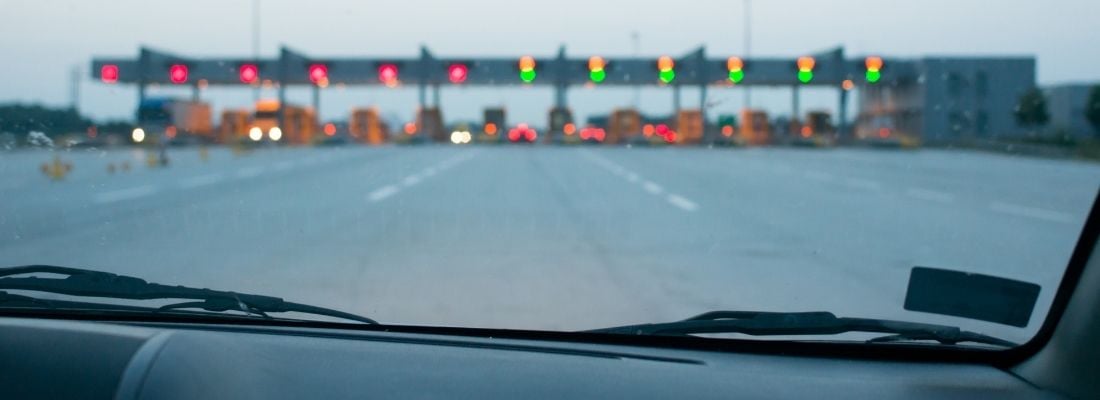Clear Recent History, part 2
In the second of our two-part feature on tolling and road and congestion pricing, Intertraffic caught up with expert consultant Norbert Schindler to find out, among other things, what trends we should be looking out for in the next couple of years.
Electronic toll collection was once the most innovative sector of the ITS industry. Do you think that is still the case at the moment? Would you consider the electronic toll collection sector to be in good shape, generally?
“That very much depends on where in the world you are. When I visited New York City this summer and travelled from New Jersey to Long Island, I still had to wait in long lines to pass the toll plaza at the George Washington Bridge. It’s truly amazing that a financial capital of the world has not moved beyond toll plazas in order for vehicles to enter Manhattan!”
“Equally surprising was my observation that there are still so many drivers who don’t have the E-Z pass tag and were queuing up to pay the toll manually. Fortunately, the Throgs Neck Bridge over to Long Island has been operating an All Electronic Tolling solution since 2017 – but the enormous gantries loaded with transponders, cameras and other sensors are real eye-catchers. Although it’s great that a Multi-Lane Free-Flow (MLFF) system is now in place, these large physical structures are surely costly to build and operate. Satellite-based tolling solutions offer an attractive alternative.”
“In the United States, satellite-based solutions are gaining traction as electric vehicles are on the rise and distance-based fees are being closely examined by a number of states to replace or to supplement the fuel tax – following the lead of Oregon, which launched the OReGO program in 2015.”
“In Europe we are witnessing lots of innovation when it comes to electronic tolling. Nationwide Global Navigation Satellite System-based tolling solutions are now operating in Germany, Slovakia, Hungary, Belgium, Russia, the Czech Republic, and Bulgaria. At this very moment, Poland is migrating from its microwave-based solution to a GNSS-based solution. The Czech Republic also rid itself of its Dedicated Short-Range Communications or DSRC-based tolling solution, tearing down hundreds of microwave gantries in 2019 when it introduced its GNSS-based system. By switching to satellite-based tolling, the cost of operations was reduced by two thirds while the tolled road network was nearly doubled."
“Also Asia is moving forward with GNSS-based tolling solutions being prepared in Singapore, Indonesia and India. It will be fascinating to watch these countries take the international lead in tolling innovation, and I look forward to seeing the impact of these fascinating tolling projects on the rest of the world.”
“If your focus is on ETC lanes at toll plazas, the future does not look very bright. Suppliers of MLFF solutions based on DSRC might also have trouble finding new opportunities, since two major reference projects – in the Czech Republic and in Poland – have just scrapped their systems, even though these countries made considerable investments in hundreds of microwave gantries that they are now tearing down. Until recently, suppliers of GNSS-based solutions had a hard time remaining profitable while competing for large national turn-key projects – mostly in Europe.”
“EETS (European Electronic Toll Service) has been a major game-changer recently, opening up the market to a number of specialized suppliers along the entire value chain of toll services, such as On Board Unit hardware, map-matching software, and OBU distribution logistics. New players, such as fuel card companies, have entered the tolling business as well.”
What do you consider to be the most innovative tolling technology of the past decade?
“If you allow me to look back to the past 11 years, I would say – without a doubt – that the “plug and play” GNSS-based On Board Unit (OBU) was by far the most innovative technological advancement we have seen in ETC. The windshield-mounted OBU, with everything integrated into one single box, was first introduced in 2010 in Slovakia and has become commonplace throughout Europe. Just Google “GNSS OBU” and click on the “images” filter of the search engine results and you will see a number of these OBUs. With the nationwide tolling system in Slovakia, we have seen a paradigm shift in the field of electronic tolling: rather than having toll roads requiring tolling infrastructure, one can now toll specific vehicles by providing them with an OBU that allows all road categories to be tolled. When the Slovak system was launched, there were only 400km of motorways and expressways in the country. With the GNSS-based approach, another 2,000 km of important transit routes on first class roads were included from the very beginning - including all the parallel roads that would have become highly congested if they were not tolled as well. This made the Slovak toll network larger than those of neighboring Austria and the Czech Republic (which both had microwave-based systems at the time).”
“In 2014, Slovakia went further and tolled all major routes, bringing the tolled road network to 17,000 km. Implementing that huge extension took only 3 months! Germany extended its tolling system in 2018 as well, from 12,000 km of motorways to 52,000 km of federal roads, making it one of the two largest toll systems in the world – along with Russia, which also implemented a GNSS-based solution.”
“The innovation in Slovakia was two-fold: a mandatory OBU that could be easily installed by the drivers themselves gave every tolled vehicle quick and easy access to the tolling system, and the potential to toll any road category since roadside infrastructure was only needed for an occasional enforcement gantry. The windshield-mounted hybrid OBU introduced in Slovakia has become the de facto standard for the European Electronic Toll Service (EETS). Just search for “EETS OBU images” in Google and you will see the tolling devices that are central to the technology revolution that is now taking place throughout Europe.”
“The vision of “one OBU, one contract, one invoice” in all of Europe is becoming a reality. There are already 12 registered EETS providers – several of which provide re-branding for fuel (card) companies such as Shell, BP, UTA and DKV. In fact, in October 2021, EETS will be mandated in all European Toll Domains. That means that countries like Slovakia, Hungary, and the Czech Republic that have their own national toll operators must provide access of the tolling market to EETS providers.”
Where does GNSS tolling fit into the overall picture?
“Everywhere! Thanks to multi-constellation GNSS, virtually all chipsets that are used for satellite positioning use at least three of the four global systems and provide an accuracy of less than 2 meters under normal conditions. Until recently, urban environments brought significant challenges with respect to position accuracy and the multi-path effects they cause on the satellite signals. These issues can be easily overcome with multi-frequency GNSS chipsets that have become incredibly inexpensive within the past few years. Galileo, the European GNSS, also provides free signal authentication that will make it very hard for criminal minds to avoid paying tolls by disrupting the satellite signal though spoofing. Today it is relatively easy to illegally manipulate satellite positioning signals to fool an OBU into thinking that is not on a tolled road when it actually is.”
What have been the barriers to wider spread implementation of electronic tolling systems across the world?
“From a technical standpoint, I don’t see any good reason for this. I guess that many tolling agencies are reluctant to innovate. They have been using toll plazas for decades and have the staff and the infrastructure in place for this. The money keeps rolling in to finance these tolling systems, so the motivation for change is probably limited. At least in the tolling sector, it seems that government mandates might be the best way to move away from these legacy systems. After all, since the 1990s we have an entire industry built around toll plazas and ETC lanes that is highly profitable.”
“Fortunately, since the turn of the century, most European road administrations didn’t buy into the toll plaza approach but went for multi-lane free flow solutions that were, for the most part, developed by local technology providers. Asia is also starting to turn away from these legacy tolling systems through initiatives taken by the political leadership. In India, for example, the Minister responsible for transportation announced last year that all toll plazas will be removed and replaced by “GPS-Tolling” – meaning that GNSS would be combined with the Indian regional satellite system called “NavIC” and the satellite-based augmentation system known as GAGAN.”
Finally, which notable tolling projects should we keep our eyes on?
“Indonesia definitely deserves our attention. At the beginning of this year, the Hungarian Roatex consortium won the contract for implementing a GNSS-based tolling system that will replace all toll plazas on 1,700km of Indonesian highways. The new multi-lane free flow tolling system will be extended to 6,000km of roads over the period of 10 years.”
“Lithuania issued a tender for the "Development of the Electronic Road Toll Information System” in March of 2021 that will be based on GNSS and fully implemented next year. The Lithuanian tender centers on OBU software requirements, with a major focus placed on the use of smartphones. This is a significant step in the evolution of GNSS-based tolling systems! Lithuania will also rely on EETS and the fact that many of the tolled vehicles entering the country will already have an EETS OBU and a toll service provider that takes care of the entire tolling process in Lithuania, from recognizing the distance travelled on the tolled roads to calculating and billing the road usage charge to its customers.”
“The Netherlands is currently planning a nationwide tolling system based on GNSS that will most likely include all passenger vehicles in addition to Heavy Goods Vehicles. The Dutch authorities are also considering the use of smartphones for tolling rather than mandating the use of tolling On Board Units, at least for light vehicles. EETS will play a major role in how the system is designed and implemented in the country, which should reduce the overhead of building up and operating the new tolling scheme.”
“The most exciting project I have seen so far is the upcoming GNSS-based tolling scheme in India. Nitin Gadkari, India’s Minister of Road Transport and Highways, announced in December 2020 that the government is planning to remove all toll plazas within the next two years. There are more than 700 toll plazas on highways across the country that support the use of RFID tags, which have recently become mandatory on the national highways. The National Highway Authority of India (NHAI) is responsible for more than 130,000 km of highways and is currently expanding the highway network at an incredible pace of more than 36 kilometers of newly built highways per day! Once India launches its new satellite-based tolling system in 2022, it will become the largest tolling system in the world.”




